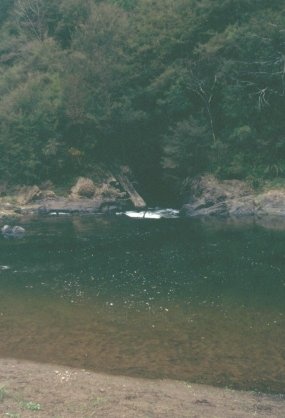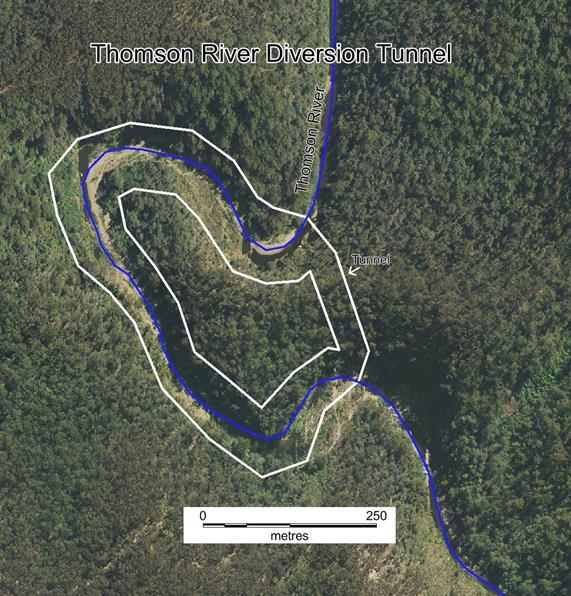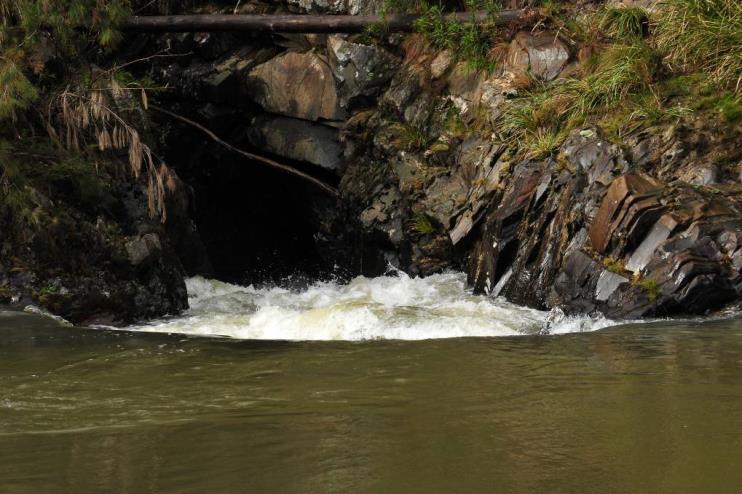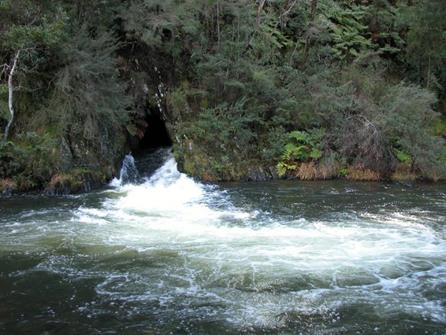THOMSON RIVER DIVERSION TUNNEL SITE
THOMSON RIVER WALHALLA, BAW BAW SHIRE
-
Add to tour
You must log in to do that.
-
Share
-
Shortlist place
You must log in to do that.
- Download report









Statement of Significance
What is significant?
The Thomson River Diversion Tunnel Site including the 220 metre tunnel through Stockriders Spur, the 1.2km section of river bed known as Horseshoe Bend between the tunnel's inlet and outlet, the inlet and outlet pools, and the river banks extending 20 metres either side of the Horseshoe Bend river bed.
History Summary
The Thomson River Diversion Tunnel Site is located near the Gippsland gold township of Walhalla. Gold was discovered in the Thomson River valley in late 1862 and a rush to the region began. Alluvial gold mining was carried out along the Thomson River for several decades from the 1860s, although quartz reef mining became the region's predominant mining industry. The Thomson River Diversion Tunnel was constructed by the Thomson River Alluvial Gold and Tailings Recovery Company between August 1911 and about October 1912. The tunnel was blasted through a slate ridge called Stockriders Spur. The purpose of the Tunnel was to divert a portion of river flows away from a 1.2 km section of the natural river bed on either side of the tunnel known as Horseshoe Bend. The decreased flow of water around Horseshoe Bend enabled the sluicing of the gravel deposits in the river bed. From the 1850s diversion tunnels, cuttings and embankments facilitated mining along rivers and creeks in a number of Victorian goldfields in mountainous regions. Diversion mining was not common and only carried out where the natural topography was suitable. The construction of the Thomson River Diversion Tunnel was an ambitious gamble and came at a time when Walhalla's quartz mining industry was ending. The mining lease at Horseshoe Bend was declared void on 10 March 1914. Over time flooding and erosion have removed all traces of mining activity in the Horseshoe Bend river bed. The diversion tunnel is the last and longest of the thirteen river diversions tunnels surviving from the Victorian gold rush period.
Description Summary
The Thomson River Diversion Tunnel Site is located about 4km south-west of Walhalla in Gippsland 1.5km south of where Stringers Creek joins the Thomson River. The tunnel has been excavated under Stockriders Spur and is 220 metres in length. The Thomson River flows to the south and the tunnel extends on a downwards incline between the inlet and outlet and has a sharp change in horizontal angle prior to both inlet and outlet. The tunnel diverts a portion of river flows away from a 1.2km section of the river bed between the inlet and outlet, which is known as Horseshoe Bend. There are deep pools of water in the river near the inlet and outlet.
How is it significant?
The Thomson River Diversion Tunnel Site is of historical significance to the State of Victoria. It satisfies the following criterion for inclusion in the Victorian Heritage Register:
Importance to the course, or pattern, of Victoria's cultural history.
Why is it significant?
The Thomson River Diversion Tunnel Site is also significant for the following reasons, but not at the State level:
There is evidence of 1870s-80s ground sluicing in various places around Horseshoe Bend on spurs (slopes) above the river bed.
-
-
THOMSON RIVER DIVERSION TUNNEL SITE - History
HISTORY
The Walhalla Goldfields
The Thomson River is one of the major waterways in the Walhalla Goldfield, a region known for quartz mining. This goldfield was one of a succession of gold discoveries in the late 1850s and early 1860s as prospectors worked further into the vast mountain ranges of eastern Victoria. The alluvial gold found in the bottom of the valley (at the site of current day Walhalla) by Ned Stringer in January 1863 derived from the erosion of gold-bearing quartz reefs on the hillsides above. With the example offered by so many earlier goldfields in Victoria, these reefs were opened rapidly.
The best of the many reefs discovered at Walhalla, Cohen's Reef, achieved astonishing levels of production in the Long Tunnel and Long Tunnel Extended ground, the Long Tunnel going on to become the State's highest gold producer historically with 815,569 ounces of gold and paying £1,283,400 in dividends. The combined production from the Long Tunnel and Long Tunnel Extended was 1,255,881 ounces, with over £2 million paid in dividends. This level of success of Walhalla quartz reefs ensured ongoing interest in gold in the area, including the gold that had eroded naturally over time into stream systems like the Thomson River.
Goldmining along the Thomson River
The mining activity undertaken along the beds and banks of the Thomson River and its tributaries was alluvial (fine metal gold or nuggets) mining. It involved the digging and sluicing of exposed river gravels, bank and slope soils, for gold. The diggings at Horseshoe Bend were mentioned in the Mining Surveyors Reports of March 1864, following the first rush to the river in early 1864. The report was an encouraging one, with numbers of miners increasing and good wages being made. In October of that year, Constable Michael Feely reported that the Thomson River miners were doing well. He said they were a 'fine, respectable and agreeable lot of men and won't allow strong drink among them. They have nice gardens well cropped with vegetables on the bank of the river and their huts are quite comfortable.'
In 1870 the Thomson River diggers struck a lead on the river, near the Thomson River Bridge. Payable results were obtained. In 1871 the Mining Surveyor reported that 'at Cooper's Creek a party are engaged in tunnelling in the bed rock, to form a tail-race for the purpose of draining the flat, which is supposed to be the old bed of the Thomson River'. By mid-1872 alluvial mining in the district was said to be confined to scattered miners, getting fair returns. In 1877, the bed and banks of the Thomson River were reported to be providing a fairly good living for the miners. The following year creek and river sluicing in the district increased and several parties on the Thomson River were making better than wages. The number of miners on the river increased again in 1879, some parties earning £4 per week per man.
The Mining Surveyor reported in 1880 that 'alluvial mining consists wholly of creek and river mining'. Another report two years later painted a different picture, with the mining surveyor writing that 'alluvial mining seems to be gradually declining, if not dying out, in this division', and speculated further that 'considering that the beds and banks of the various rivers and creeks have generally been so often turned over, the wonder is that they continue at all remunerative'. In 1886 he wrote that 'alluvial mining 'in the true sense is completely at a standstill, a few creek and river sluicers being at present the only winners of free gold, and as nearly all the beds in this division (which, by-the-bye, were never rich) have at some time or other been passed through the sluice-box, not much can be expected from this source'.
The Thomson River Diversion Tunnel
The Thomson River Diversion Tunnelseems to have had its origins in 1898, when George Weeks took up a narrow strip of the riverbed around Horseshoe Bend. Weeks' diversion scheme was nearly four and a half miles long and eleven yards in width, and included at least two flumes to transport the diverted flow across the Thomson River and a long tunnel through Horseshoe Bend. This grand scheme was never built.
Between 1911 and 1912 the Thomson River Alluvial Gold and Tailings Recovery Company undertook more modest works at Horseshoe Bend to divert a portion of the river flows by driving a tunnel through Stockriders Spur. The purpose of diversion tunnels was to divert some of the river flow away from the river bed so that it could be sluiced for alluvial gold, particularly in summertime. Horseshoe Bend was an ideal site for a diversion tunnel because it possessed a topography and features worth the financial risk - a known gold location, a suitable size and shaped spur through which a tunnel would make a very long section of the river bed accessible, and the existence of a large rock bar to facilitate stream flow into a tunnel built upstream from it.
The work at Horseshoe Bend commenced in 1911. Labour problems after the first 215 feet forced the company to tender out the completion of the tunnel, and the contract was awarded to William John (Jack) Hannaford. Jack pushed on, opening two faces, and leaving a small strip of rock at the inlet end. By 18 September 1912 the tunnel was 533 feet long and nearing completion, and in October the tunnel was finally opened with a gala day. The last charges were set on a thin wall of rock, but rather than wait for a signal from Jack, the miner who was to set the explosives off got impatient and lit the fuses. The wall was breached and water flooded through the tunnel. Unbeknown to him, Jack had let his wife and three oldest children have one last ride in the trolley, and they were swept from the tunnel in a torrent of water. Fortunately his wife Clara was a good swimmer and rescued all the children.
Once completed, a portion of the flows of the Thomson River flowed through the tunnel, allowing the river bed to be sluiced for alluvial gold. The results of the mining that followed are not known, and it has been assumed that because no reports followed, the operation was not very successful. The lease was declared void on 10 March 1914, less than 18 months later. It may be that that this was sufficient time to completely strip the river bed around the bend, after which time the company would have had no further interest in that section of creek. Gold mining across Victoria decreased dramatically with the advent of World War I (1914-18). The Thomson River Alluvial Gold and Tailings Recovery Company No Liability was struck off the companies register in 1943.
KEY REFERENCES
Rob Kaufman, Historic Heritage Survey: Horseshoe Bend Gold Mining Area, Thomson River, Victoria, Report prepared for West Gippsland Catchment Management Authority, 5 October 2010.
David Bannear, Victorian Goldfields Project: Assessment of Historic Gold Mining Sites, Reports produced by for the former Department of Conservation, Forests & Lands and Department of Natural Resources & Environment between 1990 and 1999.
THOMSON RIVER DIVERSION TUNNEL SITE - Assessment Against Criteria
Criterion
How is it significant?
The Thomson River Diversion Tunnel Site is of historical significance to the State of Victoria. It satisfies the following criterion for inclusion in the Victorian Heritage Register:
Criterion A
Importance to the course, or pattern, of Victoria's cultural history.
Why is it significant?
The Thomson River Diversion Tunnel Site is significant at the State level for the following reasons:
The Thomson River Diversion Tunnel Site is historically significant as one of the last and longest of the thirteen diversion tunnels constructed for gold mining purposes in the Victoria. The tunnel was constructed between 1911 and 1912. Through its design and form the tunnel demonstrates the diversion mining technology used to divert a portion of river flows away from natural waterways and enable the digging and sluicing of river bed deposits for alluvial gold. Water diversion systems were not common in Victoria and limited to gold mining regions with a mountainous topography and perennial waterways. The looping alignment of the Thomson River at Horseshoe Bend, being an already known gold bearing locality, and the presence of Stockriders Spur are also significant as they made made this location particularly suitable and were in an already known gold bearing locality. Water diversion systems are important to understanding Victoria's gold mining history. [
Criterion A]
The Thomson River Diversion Tunnel Site is also significant for the following reasons, but not at the State level:
There is evidence of 1870s-80s ground sluicing in various places around Horseshoe Bend on spurs (slopes) above the river bed.
The Thomson River Diversion Tunnel Site is a place of co-existing natural and cultural heritage values. The Thomson River is listed as a Heritage River under Heritage Rivers Act 1992.
THOMSON RIVER DIVERSION TUNNEL SITE - Permit Exemptions
General Exemptions:General exemptions apply to all places and objects included in the Victorian Heritage Register (VHR). General exemptions have been designed to allow everyday activities, maintenance and changes to your property, which don’t harm its cultural heritage significance, to proceed without the need to obtain approvals under the Heritage Act 2017.Places of worship: In some circumstances, you can alter a place of worship to accommodate religious practices without a permit, but you must notify the Executive Director of Heritage Victoria before you start the works or activities at least 20 business days before the works or activities are to commence.Subdivision/consolidation: Permit exemptions exist for some subdivisions and consolidations. If the subdivision or consolidation is in accordance with a planning permit granted under Part 4 of the Planning and Environment Act 1987 and the application for the planning permit was referred to the Executive Director of Heritage Victoria as a determining referral authority, a permit is not required.Specific exemptions may also apply to your registered place or object. If applicable, these are listed below. Specific exemptions are tailored to the conservation and management needs of an individual registered place or object and set out works and activities that are exempt from the requirements of a permit. Specific exemptions prevail if they conflict with general exemptions. Find out more about heritage permit exemptions here.Specific Exemptions:PERMIT EXEMPTIONS (UNDER SECTION 42 OF THE HERITAGE ACT)
It should be noted that Permit Exemptions can be granted at the time of registration (under s.42(4) of the Heritage Act). Permit Exemptions can also be applied for and granted after registration (under s.66 of the Heritage Act)General Condition 1
All exempted alterations are to be planned and carried out in a manner which prevents damage to the fabric of the registered place or object.General Condition 2
Should it become apparent during further inspection or the carrying out of works that original or previously hidden or inaccessible details of the place or object are revealed which relate to the significance of the place or object, then the exemption covering such works shall cease and Heritage Victoria shall be notified as soon as possible.General Condition 3
All works should be informed by Conservation Management Plans prepared for the place. The Executive Director is not bound by any Conservation Management Plan, and permits still must be obtained for works suggested in any Conservation Management Plan.General Condition 4
Nothing in this determination prevents the Heritage Council from amending or rescinding all or any of the permit exemptions.General Condition 5
Nothing in this determination exempts owners or their agents from the responsibility to seek relevant planning or building permits from the relevant responsible authority, where applicable.Specific Permit Exemptions
Diversion Tunnel
.Emergency and general maintenance.
.Installation of any safety equipment or earthworks required for public safety or to leave sections in a safe condition.
.Monitoring of structural integrity of tunnel.Landscape and River
.Removal or lopping of trees and vegetation.
.Revegetation works
.Works to or extension of existing tracks.
.Undertaking of safety and access works to restrict foot traffic access.
.Installation of information signage for interpretation and public risk purposes.Waterway Management
.Minor waterway management activities, provided that there is no adverse impact on the cultural heritage significance of the place.Fire Suppression Duties
.Fire suppression and fire-fighting duties provided the works do not involve the removal or destruction of any significant above-ground features or sub-surface archaeological artefacts or deposits.
.Fire suppression activities such as fuel reduction burns, and fire control line construction, provided all significant historical and archaeological features are appropriately recognised and protected.
Note: Fire management authorities should be aware of the location, extent and significance of historical places when developing fire suppression and fire-fighting strategies. The importance of places listed in the Heritage Register must be considered when strategies for fire suppression and management are being developed.Weed and Vermin Control
.Weed and vermin control activities provided the works do not involve the removal or destruction of any significant above-ground features or sub-surface archaeological artefacts or deposits.
.Removal of plants listed as noxious weeds in the Catchment and Land Protection Act 1994.
Note: Particular care must be taken with weed and vermin control works where such activities may have a detrimental effect on the significant fabric of a place. Such works may include the removal of ivy, moss or lichen from an historic structure or feature.Public Safety and Security
.Public safety and security activities provided the works do not involve the removal or destruction of heritage fabric;
.The erection of temporary security fencing, scaffolding, hoardings or surveillance systems to prevent unauthorised access or secure public safety which will not adversely affect the fabric of the place;
.Development including emergency stabilisation necessary to secure safety where a site feature has been irreparably damaged or destabilised and represents a safety risk to its users or the public.
Note: Urgent or emergency site works are to be undertaken by an appropriately qualified specialist such as a structural engineer, or other heritage professionalSignage and Site Interpretation
.Signage and site interpretation activities provided the works do not involve the removal or destruction of any heritage fabric;
.The erection of non-illuminated signage for the purpose of ensuring public safety or to assist in the interpretation of the heritage significance of the place or object and which will not adversely affect heritage fabric or obstruct significant views of and from heritage fabric;
.Signage and site interpretation products must be located and be of a suitable size so as not to obscure or damage heritage fabric;
.Signage and site interpretation products must be able to be later removed without causing damage to heritage fabric.
Note: The development of signage and site interpretation products must be consistent in the use of format, text, logos, themes and other display materials.
Note: Where possible, the signage and interpretation material should be consistent with other schemes developed on similar or associated sites. It may be necessary to consult with land managers and other stakeholders concerning existing schemes and strategies for signage and site interpretation.THOMSON RIVER DIVERSION TUNNEL SITE - Permit Exemption Policy
PERMIT POLICYPreamble
The purpose of the Permit Policy is to assist when considering or making decisions regarding works to a registered place. It is recommended that any proposed works be discussed with an officer of Heritage Victoria prior to making a permit application. Discussing proposed works will assist in answering questions the owner may have and aid any decisions regarding works to the place.The extent of registration of the Thomson River Diversion Tunnel Site in the Victorian Heritage Register affects the whole place shown on Diagram 1990 including the land, tunnel and other features. Under the Heritage Act 1995 a person must not remove or demolish, damage or despoil, develop or alter or excavate, relocate or disturb the position of any part of a registered place or object without approval. It is acknowledged, however, that alterations and other works may be required to keep places and objects in good repair and adapt them for use into the future.
If a person wishes to undertake works or activities in relation to a registered place or registered object, they must apply to the Executive Director, Heritage Victoria for a permit. The purpose of a permit is to enable appropriate change to a place and to effectively manage adverse impacts on the cultural heritage significance of a place as a consequence of change. If an owner is uncertain whether a heritage permit is required, it is recommended that Heritage Victoria be contacted.
Permits are required for anything which alters the place or object, unless a permit exemption is granted. Permit exemptions usually cover routine maintenance and upkeep issues faced by owners as well as minor works or works to the elements of the place or object that are not significant. They may include appropriate works that are specified in a conservation management plan. Permit exemptions can be granted at the time of registration (under s.42 of the Heritage Act) or after registration (under s.66 of the Heritage Act).
Cultural heritage management plans
It is recommended that a Conservation Management Plan (CMP) is developed to manage the place in a manner which respects its cultural heritage significance. The following documents may be useful in the management of the cultural heritage at this place.
.Rob Kaufman, Historic Heritage Survey: Horseshoe Bend Gold Mining Area, Thomson River, Victoria, Report prepared for West Gippsland Catchment Management Authority, 5 October 2010.Aboriginal cultural heritage
If any Aboriginal cultural heritage is discovered or exposed at any time it is necessary to immediately contact Aboriginal Victoria to ascertain requirements under the Aboriginal Heritage Act 2006.Other approvals
Please be aware that approval from other authorities (such as local government) may be required to undertake works.Archaeology
Ground disturbance may affect the archaeological significance of the place and, subject to the exemptions stated in this document, requires a permit.
Relative cultural heritage significance at the place
All features listed here are of primary cultural heritage significance in the context of the place. A permit is required for most works or alterations. See Permit Exemptions section for specific permit exempt activities:
.Diversion tunnel
.Inlet and outlet pools
.Riverbed and banks and 20 metres either side of the banksLand: All of the land identified in Diagram 1990 is of primary cultural heritage significance.
Natural heritage values
The Thomson River Diversion Tunnel Site is a place of co-existing environmental and cultural heritage values. The Thomson River is listed as a Heritage River under Heritage Rivers Act 1992. The management of this place may usefully be guided by the Australian Natural Heritage Charter.The Australian ICOMOS Charter for Places of Cultural Heritage Significance (the Burra Charter) provides guidance on the management of places which can be applied to places of cultural significance including natural, Indigenous and historic places with cultural values. The definition of 'place' under the Burra Charter has a broad scope and includes natural and cultural features. Natural elements of a place may constitute cultural heritage fabric.
The Burra Charter urges a cautious approach to understanding and managing places with co-existing cultural and natural heritage values. Article 5 ('Values') of the Burra Charter states that:
5.1 Conservation of a place should identify and take into consideration all aspects of cultural and natural significance without unwarranted emphasis on any one value at the expense of others.
5.2 Relative degrees of cultural significance may lead to different conservation actions at a place.
-
-
-
-
-
THOMSON RIVER MINE SHAFT & ADIT
 Victorian Heritage Inventory
Victorian Heritage Inventory -
EVANS BROTHERS LIMEWORKS
 Victorian Heritage Inventory
Victorian Heritage Inventory -
SLUICE WORKINGS, NORTH ZONE, HORSESHOE BEND
 Victorian Heritage Inventory
Victorian Heritage Inventory
-
'NORWAY'
 Boroondara City
Boroondara City -
1 Mitchell Street
 Yarra City
Yarra City
-
-









